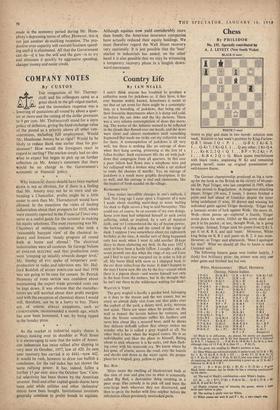Chess
By PHILIDOR
No. 135. Specially contributed by A. J. LEVETT (New South Wales) BLACK (6 men)
WHITE (7 men)
WHITE to play and mate in two moves: solution next week. Solution to last week's problem by King-Farlow: Q-B 7, threat 2 Q x P. 1 . . . Q-B 6; 2 Kt-K 2.
I Q-Kt 7; 2 Kt-Q 3. I . . . Q any other ; 2 Kt-Q 4.
1 . . . Kt-K 2; 2 Q x Q. 1 B Is x P;2 Kt x P.
1 . . . K-B 4; 2 Q x Q. Black queen interferences with black rooks, unpinning W Kt and remaining pinned herself, make up original presentation of well-known theme.
The German championship produced as big a turn- up for the book as the British in the victory of 44-year- old Dr. Paul Troger, who last competed in 1949, when he was second to Bogoljubow. A dangerous attacking player, Trager (10 wins, 2 losses, 3 draws) finished a point and half ahead of Unzicker despite the latter being undefeated (5 wins, 10 draws) and winning his individual game against Trager decisively. Trager had a fantastic stroke of luck against Wolk. On move 31, Wolk—three pawns up—captured a fourth; Troger wrote down his move, folded up his score sheet and put it in his pocket; at last, thought Wolk, he is going to resign. Instead, Trager took his queen from Q Kt 2, put it on K R 8, and said 'mate.' Moreover, White king being on K B 1 and pawn on K 2, it was mate. However, as Trager said afterwards, 'Must I apologise for that?' What we should all like to know is what Unzicker said.
The following bizarre game won (rather luckily, I think) first brilliancy prize: the winner won only one other game and finished last but one.
White, HODAKOWSKY Black, HEINRICH Opening, Nimzo Indian.
1 P-Q 4 Kt-K B 3 21 R x Kt P (c) Q R-Kt 1 (d) 2 P-Q B 4 P-K 3 22 R x R R x R 3 Kt-Q /3 3 B-Kt 5 23 B x B1 R-Kt 8 4 P-K 3 0-0 240 x R Kt-Q 7 ch 5 P-Q R 3 B x Kt ch 25 K-Kt 2 Kt x Q (a)
6 P x B P-B 4 26 Kt-R 5 Q-Kt 3 (f)
7 B-Q 3 Kt-B 3 27 B-B 5! Q x Kt 8 Kt-K 2 P-Q 3 28 P-Kt 4 Q x B 9 P-K 4! P-K 4 29 K P x 0 Kt x P
10 B-Kt 5 P-K R 3 30 R-R 1 (h) Kt-B5
11 B-R 4 BP x P 31 R-R4 P.-Q4 12P x P Q-R4ch 32 R x P K-B I
13 K-B I P x P? (a) 33 R x P P-Q 6
14 B x Kt P x B 34 K-B I P-R 4 15 R-Q Kt I P-R 3 35 P-Kt 5 Kt-Q 7 ch 16 Kt-B 4 Q-K Kt 4 36 K-K 1 Kt-B 6 ch 17 P-Kt 3 Kt-K 4 37 K-Q 1 K-K 2 18 P-KR 4 Q-Kt 2 38 R-KR 6 Kt x RP
19 R-Kt 6 B-Kt 5 (b) • 39 R-R 7Kt x P
20 B-K 2! Kt x P7 40 P-Kt 6 K-Kt 3
41 P x P Resigns (I)
(a) Black is in difficulties. As played, his pawns arc shattered. and he dare not move the K Kt first because of P-Q 5 followed by B-K 7. I believe 13 ... P-K Kt 4; 14 B-Kt 3, Kt-R 4; is best, although risky (if 15 P-K R 4, then 15 ... P-Kt 5).
(b) No good, but nothing is: Black's position is lost.
(c) Here White can win more simply, it seems to me, by 21 B x Kt x R; 22 Kt-R 5, Q-R 1 (22 . . . Q-Kt 3?; 23 B-US); 23 II(11 X P, Kt-B l; 24 Kt x P ch, K-Kt 2; and now either 25 Kt-Q ch regaining the exchange and remaining a pawn up, or 25 K-Kt I followed by R-Q B l-B 7. (d) 21 . . B x B ch; 22 Kt x 131, Kt x P; 23 Kt x P gives Black better chances, but he thinks he has a winning combination up his sleeve.
(e) The end of Black's combination—now White's begins.
(f) 26 ... Q x B7?; 27 Kt x P ch or 26 ... Q-B I; 27 R x Kt with R, B and Kt for Q. (g) Highly original way of winning the queen, which 1 hare never seen before in play.
(h) The ending is easily won for White. (1) White comes out with R and P v. Kt, a Wry simple wia.


































 Previous page
Previous page